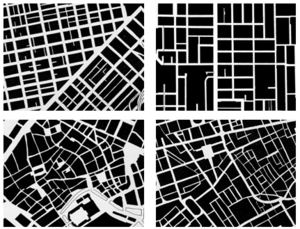Visible Cities - Special Delivery!
| Visible Cities - Special Delivery! | |
|---|---|

| |
| Designer: | Adam Nelson; based on Visible Cities by Kevan Davis and Holly Gramazio |
| Year: | unknown |
| Players: | 50-100 |
| Stuff required: | Hats for each gatekeeper. Costumes for each chaser. Universe badges (ribbons, LED badges, etc) for all players. |
| Crew required: | 18 |
| Preparation: | One day |
| Time required: | Game lasts 1-2 hours; each mission lasts ~ 20 minutes |
| Place required: | A large urban area of at least one street, several blocks long. |
| Activities: | Running, hiding, evading, trading, delivering |
| This is a playable game - it's finished, tested and ready to play. | |
| This game is made available under an Attribution-Noncommercial Creative Commons licence. (What does this mean?) | |
Visible Cities - Special Delivery! invites players to see their city in a new way. Players pass through multiple universes in an attempt to deliver a special package, all while ensuring their delivery isn’t stolen by a chaser.
History and Influences
Visible Cities - Special Delivery! is a pervasive game based on “Visible Cities” by Kevan Davis and Holly Gramazio. It was featured at the GA/GI festival in Pittsburgh on April 1, 2011, with 50-60 members of the public as players.
Playing Space
A large, walkable urban area of at least one street several blocks long, with numerous small shops or other areas where gatekeepers can stand.
Number of Players
30-100
Gameplay and Rules
Players begin in one particular universe, and must deliver a package or envelope to a specific location in another universe. Players enter new universes by passing through gates and changing the colors of their badges. In each universe, chasers attempt to tag players and destroy their packages.
Rules
1. A player’s badge represents their universe. He or she must always wear it in a way that is visible to other players and chasers.
2. There are at least four alternate universes. Players start in one universe and deliver a package to another, using particular storefronts or other locations as gates from one world to the next.
3. Players look for gatekeepers in their universe, with the same-colored badge as them. Gatekeepers can pass players through to another universe by giving players a new badge. Each gate is one-way and leads to only one other universe, and gatekeepers must tell players to which universe their gate leads.
4. Players can only talk to players and gatekeepers in their own universe: red-to-red, green-to-green, etc. All other players and gatekeepers are invisible to you.
5. Players must deliver packagers unharmed! If a package is destroyed by a chaser, players can go to a gate in their current universe to get a new one.
6. After delivering a package, a player may play again (suggesting that the player to make the most successful deliveries within a certain time frame could be the winner of the game).
Notes for Organizers
This game requires at least one crew member for each gate to serve as gatekeepers, as well as as many crew members as there are universes to serve as chasers. For example, in a 4-universe game with 12 gates, 16 crew members would be required. One or two additional “floaters” is also a good idea.
As with the original Visible Cities, we used a 4-3-3-2 distribution of gates (4 Blue, 3 Red, 3 White, and 2 Green). In addition, while each gate led to only one other universe, we further limited the universes each gate could lead to. Blue gates only lead to Red or White, Red gates only to White or Green, White Gates only to Green or Blue, and Green Gates only to Blue or Red. To force players to pass through at least two gates, players had to deliver packages to a universe they could not immediately access via their start gate (e.g., Blue delivers to Green, Red to Blue, White to Red, and Green to White).
Unlike the original Visible Cities, we did not provide players with a map, for two reasons. One, the playing area was a few blocks along a single main street, meaning players could readily find new gate locations. Two, we wanted to encourage players to have a higher level of interaction with one another by forcing them to ask other players or crew for the location of specific gates (i.e., their delivery destinations).
To make them easier to recognize, all of our gatekeepers wore a piece of clothing representative of their universe (An LED-tentacle hat for the Blue “Underwater” universe, big sunglasses for the Red “Desert” universe, furry earmuffs for the White “Arctic” universe, and ranger hats for the Green “Forest” universe. Furthermore, we themed the gates as alternate-universe storefronts, but placed them at abandoned locations along the street, with the intention of encouraging players to see their city for what it could be, not just what it is.
Rule Variants
Working with four universes was fine, but, in order to keep players from immediately jumping to within one step of their target universe, required an additional rule stating players may not pass through their start gate to a new universe. This was a little counter-intuitive with regard to the play of the game, and as such, we recommend a five-universe game in which this rule is largely unnecessary, as players still must pass through at least two universe before arriving at their destination universe.
Additional Resources
- Rules handout, Side 1.
- Rules handout, Side 2.
